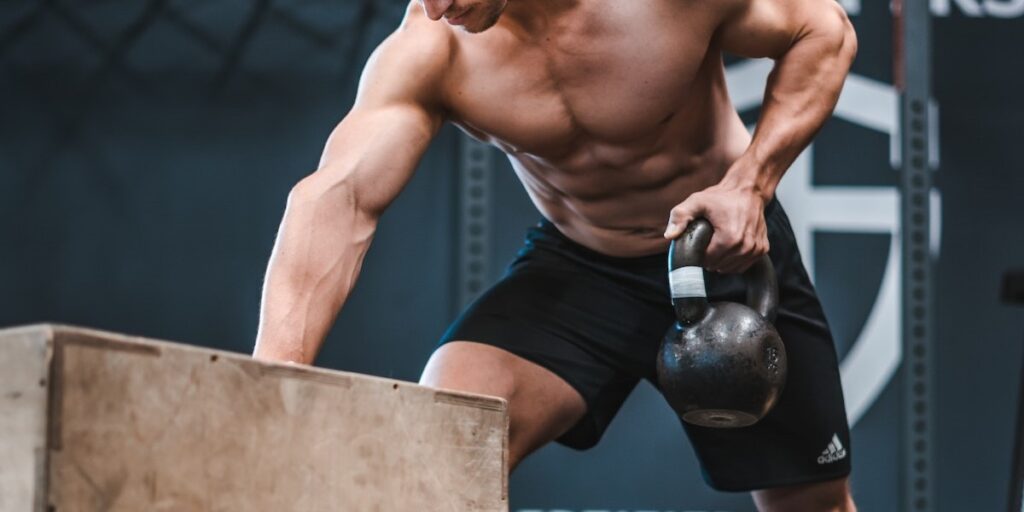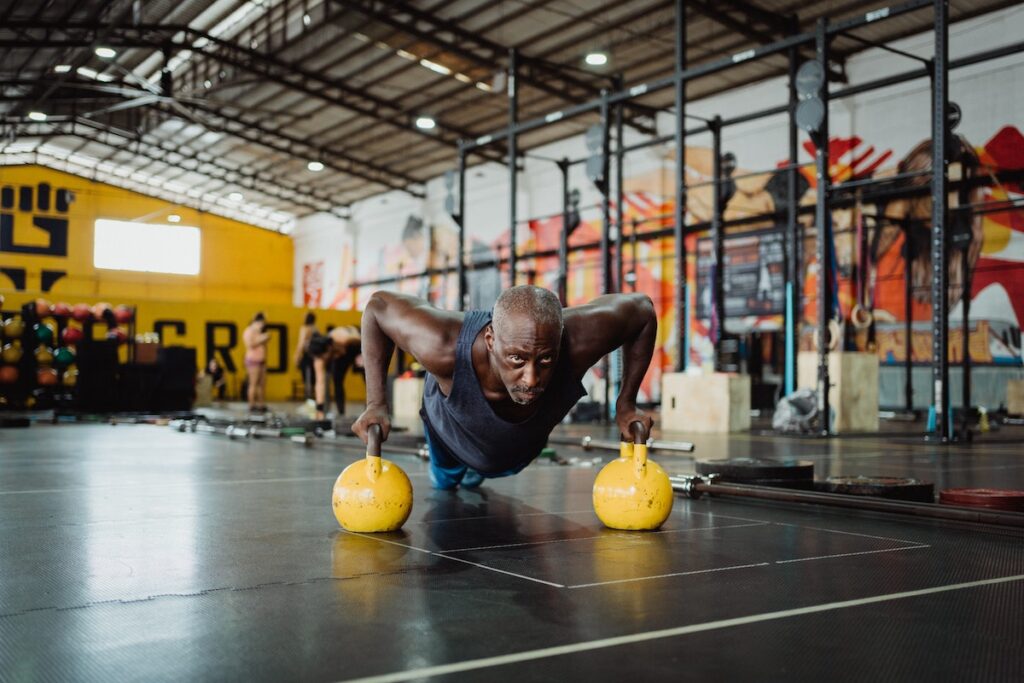
Kettlebell chest exercises, often overshadowed by their barbell and dumbbell counterparts, are a hidden gem in the fitness world. These dynamic, versatile workouts target not only the chest muscles but also the shoulders, core, and even the cardiovascular system.
In this article
Let’s explore the most effective kettlebell chest exercises for various skill levels and the benefits of incorporating them into your routine. Grab your kettlebell, and let’s get started on the path to a stronger, healthier chest!
Top 7 best kettlebell chest exercises
Here are 7 best kettlebell chest exercises to help you build strength and stability in your upper body:
1. Kettlebell Floor Press
How to do it:
- Get into a supine position with a kettlebell to the side of your shoulder.
- Grab the kettlebell with an underhand grip and position your arm at 45˚.
- Pull your shoulder blades down and back, pressed to the ground.
- Press the kettlebell straight up like you would a floor press, with the kettlebell at upper chest level.
2. Kettlebell Chest Press
How to do it:
- Lie on your back with your knees bent and feet flat on the floor.
- Hold a kettlebell between your two hands, resting on your chest.
- It should be in a comfortable position.
- Take a deep breath and then drive the kettlebell straight up in the air. Pause, and then slowly lower it back down to the starting position.
3. Single-Arm Kettlebell Bench Fly
How to do it:
- Position yourself on a flat bench, with your feet firmly planted on the floor.
- Grasp the kettlebell handle with an overhand grip in one hand.
- Lay back on the bench and extend the arm holding the kettlebell straight above your chest. This will be your starting position.
- Slowly lower the kettlebell in a controlled manner out to the side, keeping your arm slightly bent at the elbow. Make sure to maintain a stable position with your shoulders and back on the bench.
- When you reach the point where you feel a stretch in your chest muscles, pause for a moment.
- Contract your chest muscles to bring the kettlebell back to the starting position, following the same arc motion used during the lowering phase.
4. Kettlebell Push-Up
How to do it:
- Place a kettlebell on the floor and get into a push-up position with one hand on the kettlebell handle and the other on the floor.
- Perform a push-up, maintain proper form, and switch sides.

5. Kettlebell Pullover
How to do it:
- Lie on your back on a bench, holding a kettlebell with both hands above your chest.
- Slowly lower the kettlebell behind your head, keeping your arms straight, and then return to the starting position.
6. Kettlebell Single-Arm Floor Press
How to do it:
- Begin in a side-lying position with the kettlebell next to your body.
- Grasp the handle with both hands and slowly roll onto your back.
- Once you are lying flat on the floor, bend your knees to roughly 45 degrees and slide your heels toward your butt.
- Transfer the kettlebell to one hand, with your upper arm supported by the floor and your palm facing in.
- Press the kettlebell straight up toward the ceiling, rotating your wrist.
- Lower the kettlebell back to the starting position and repeat for the desired number of repetitions.
- Switch to the other arm and perform the same number of repetitions.
7. Kettlebell Chest Press with Leg Raise
How to do it:
- This exercise combines the kettlebell chest press with a leg raise to engage the core and lower body.
- Lie on your back with knees bent and feet flat on the floor, holding a kettlebell in both hands above your chest.
- As you press the kettlebell up, simultaneously lift your legs off the ground, keeping them straight.
[Related: How to Lose Stubborn Fat and Get Nice Muscle Definition]
How Many Sets and Reps Should I Do?
Aim for 3-4 sets of 8-15 reps for each exercise. You can adjust the weight of the kettlebell and the number of reps and sets to increase or decrease the difficulty of the exercise.
It’s important to listen to your body and avoid overtraining, so start with a weight and number of sets and reps that feel comfortable for you and gradually increase as you become stronger and more comfortable with the movements.
Why train your chest with kettlebells?
Incorporating kettlebell chest exercises into your routine can offer several benefits, including:
1. Improved strength and muscle growth
Kettlebell chest exercises can help you build strength in your chest muscles (pectoralis major and minor), shoulders, and triceps. The unique loading pattern of kettlebells helps stimulate muscle growth and improves overall upper-body strength.
2. Core engagement
Kettlebell exercises engage your core muscles to provide stability and balance during the movements, which is essential for maintaining proper posture and preventing lower back pain.
[Related: 10 Best Core Workouts for Men: Strengthen Your Abs, Obliques, & Lower Back]
3. Increased functional strength
Kettlebell exercises mimic real-life movements, helping you develop functional strength that translates to improved performance in daily activities and sports.
4. Improved joint stability
Kettlebell chest exercises involve multiple joints and muscle groups, which can help improve joint stability, particularly in the shoulder girdle.
Check out this video called “What Happens to Your Body if You Exercise with Kettlebells Every Day” from the “Chromosome” Youtube channel.
Safety tips for kettlebell chest exercises
When performing kettlebell chest exercises, it is essential to follow safety tips to prevent injury and ensure proper form. Here are some safety tips to consider:
1. Choose the right weight
Select a kettlebell weight that is suitable for your fitness level and allows you to maintain proper form throughout the exercise.
2. Warm-up
Before starting your kettlebell chest workout, perform a warm-up to prepare your body for the exercises and reduce the risk of injury.
3. Maintain proper form
Pay attention to your body alignment and posture during kettlebell chest exercises. For example, when performing a kettlebell floor press, get into a supine position, grab the kettlebell with an underhand grip, position your arm at a 45-degree angle, and pull your shoulder blades down and back, pressed to the ground.
4. Engage your core
Activating your core muscles helps stabilize your body during kettlebell chest exercises, improving your balance and overall exercise performance.
5. Controlled movements
Perform kettlebell chest exercises with slow, controlled movements to ensure proper form and reduce the risk of injury. For example, when performing a kettlebell chest press, take a deep breath, drive the kettlebell straight up in the air, pause, and then slowly lower it back down to the starting position.
6. Progress gradually
Increase the weight, sets, or reps of your kettlebell chest exercises progressively, allowing your body to adapt to the increased workload.
7. Proper positioning
When using kettlebells, ensure the weight is positioned correctly to avoid unnecessary strain on your muscles and joints. For example, when holding a kettlebell on your chest, it should be in a comfortable position.
8. Strengthen your back muscles
Strengthening your back muscles can help counteract the force of the kettlebell pulling you forward, improving your posture during exercises.
Frequently asked questions (FAQ)
Got more questions about kettlebell chest exercises? Check out some commonly asked questions about this topic below.
How often should I perform kettlebell chest exercises?
It’s recommended to incorporate kettlebell chest exercises into your workout routine two to three times per week. Ensure you have at least one rest day between workouts for proper recovery and muscle growth.
Can kettlebell chest exercises replace traditional bench press exercises?
While kettlebell chest exercises can effectively target the chest muscles, they may not entirely replace traditional bench press exercises. However, they can serve as a valuable addition to your workout routine, providing variety and targeting supporting muscle groups.
What is the appropriate kettlebell weight for chest exercises?
The appropriate kettlebell weight for chest exercises varies depending on your fitness level and experience. Start with a lighter weight, focusing on proper form and technique, and gradually progress to heavier weights as you build strength and confidence.
Discover a beginner-friendly, full-body kettlebell workout by checking out The Best Kettlebell Full Body Workout Routine for Beginners.
Final Word
Ready to transform your chest workouts with kettlebell chest exercises? By incorporating these dynamic, versatile exercises into your fitness routine, you’ll experience improved chest strength, increased shoulder, and core stability, and enhanced cardiovascular fitness.
Remember to prioritize proper form, technique, and safety while challenging yourself with progressive exercises. If you found this article helpful, share it with a friend, and check out my full blog for more tips on health and fitness.
